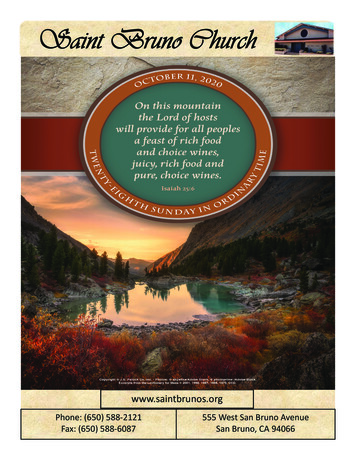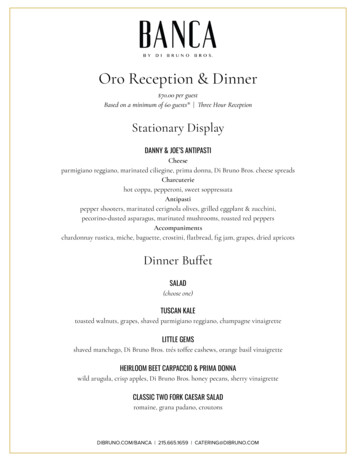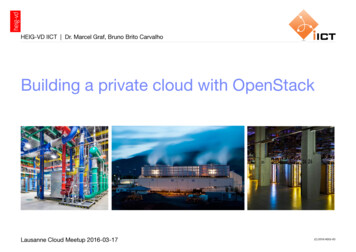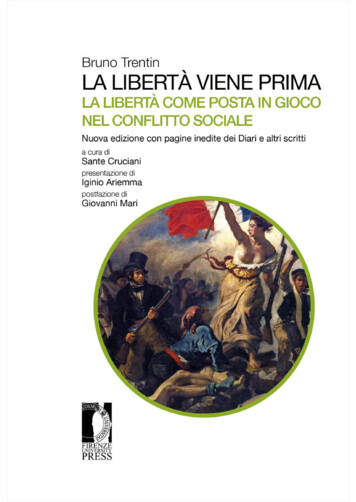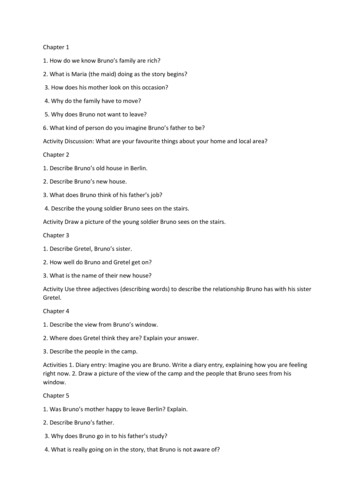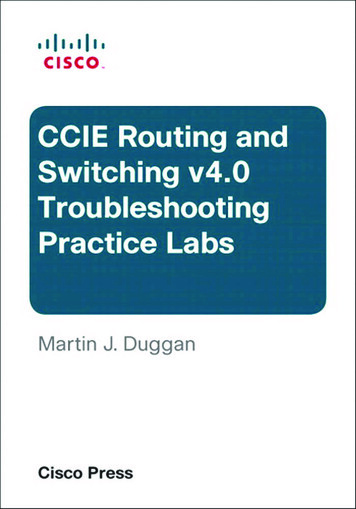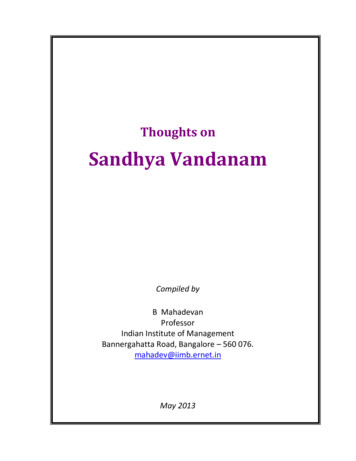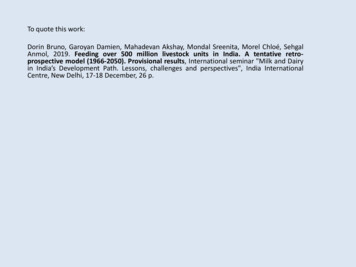
Transcription
To quote this work:Dorin Bruno, Garoyan Damien, Mahadevan Akshay, Mondal Sreenita, Morel Chloé, SehgalAnmol, 2019. Feeding over 500 million livestock units in India. A tentative retroprospective model (1966-2050). Provisional results, International seminar "Milk and Dairyin India’s Development Path. Lessons, challenges and perspectives", India InternationalCentre, New Delhi, 17-18 December, 26 p.
Feeding over 500 million livestock units in IndiaA tentative retro-prospective model visional resultsBruno DORIN (CIRAD-Montpellier, CIRED-Paris, CSH-Delhi)Damien GAROYAN (CSH-Delhi, 2015-16)Akshay MAHADEVAN (CSH-Delhi, 2019)Sreenita MONDAL (CSH-Delhi, 2018)Chloé MOREL (CSH-Delhi, 2019)Anmol SEHGAL (CSH-Delhi, 2019)International seminar "Milk and Dairy in India’s Development Path”New Delhi, 17-18 December 2019
Key messages❶ Globally, growing consumptions and productionsof animal products (meat, milk ) and animal feed (cereals, oilcakes )have huge environmental impacts(deforestation, CH4 and N20 emissions, energy and water consumptions )and challenge both food security (food/feed competition for poor/rich consumer)and food sovereignty of land-squeezed countries (e.g. China, or even EU)❷ India is a confusing case in this storyline,but its unique model is very poorly documented,starting with national statistics on production and consumption of feeds,leading to diverging or inconsistent results from national/international models❸Using the current state of the art (NIANP 2003, Gorti et al 2012 )we have extended and improved past assessments and bio-modellingto better project future scenarios and their impactsfor an Indian populationthat is expected to peak at 1.723 billion people in 2071 (IIASA 2018)All in all: Livestock feed and human consummation of animal productshave been largely overlooked by most Indian stakeholders focused on foodgrains(statisticians, economists, agricultural scientists, nutritionists, environmentalists, policy makers )and this must change urgently and drastically: we tried to work in this direction 2
The global challenge❶ Global past picture: growing food crops for feeding livestock (1961-2007)Source : Dorin (2011)35Tkcal/ /jourdayTkcalProduction of PLANT food: 186 %Seeds,biofuels,wastes 30Feed forANIMALS( 185%)2520Cereals, oilcakes, edible roots 15Livestock production systemsFood forHUMANS( 052010TkcalTkcal/ /jourday3,53,0Monogastrics( 384%)2,5Meat, milk, eggs 2,0Production of ANIMAL foodstuffs: 166 %1,5Ruminants( 103%)1,00,50,01960FEED /animalFOOD 3On world average,we used3 kcal or protein of PLANT foodto produce1 kcal or protein of ANIMAL food3
Global picture in 2050: according to 5 possible diet scenarios!Consumption in Plant Food Product (PFP)Economical& social issuesPlant food (Tkcal.day-1)65605550waste & seedanimal feedhuman food economic growth ? income inequalities ? animal draft vs. tractors ? manure vs. chemical fertilizer ? wool, leather ? cultural preferences,religious taboos ? / 4540353025Heath issues20151050REF-2007VEG-2050REF-2050Situationin 2007All VEGin 2050Same dietsas in 2007AG1-2050AGO-2050WST-2050ScenarioAgrimonde GOScenario(trend)Agrimonde 1FullWesternin 2050(under- & over-consumption) proteins, lipids, iron, vitamin A ? overweight, obesity ? cardiovascular diseases ? / Environmental issues deforestation (C, biodiversity) ? GHG (N2O, CH4, CO2) ? fertilizers, freshwater, pesticides / Source: Dorin Bruno, Le Cotty Tristan, 2012. "Food Crops and Livestock. From Worldwide Past Evidences (1961-2007) to Open Scenarios (2050)",12th Biennial Conference of the International Society for Ecological Economics, Rio de Janeiro, 16-19 June, 34 p. Le Cotty Tristan, Dorin Bruno, 2012. "A global foresight on food crop needs for livestock", Animal, 6:9, Sept., pp. 1528-36. Paillard Sandrine, Tréyer Sébastien, Dorin Bruno (Dir.), 2011 (2014: Springer). Agrimonde: scenarios and challenges for feeding the world in 2050,Quae, Versailles, 295 p.4
Asia and Africa: the big playersConsumption in Plant Food Product (PFP)-1Plant food (Tkcal.day ST-2050Source:Dorin Bruno, Le Cotty Tristan, 2012. "Food Crops and Livestock. From Worldwide Past Evidences (1961-2007) to Open Scenarios (2050)",12th Biennial Conference of the International Society for Ecological Economics, Rio de Janeiro, 16-19 June, 34 p.5
❷The big Indian puzzle Contrasting trends Vegetarianism as a value for upper classes (“sanskritization”) Land-shortage and high food-feed competitionleading to a large use of by-products for animal feed (crops residues, food waste, forest ) But growing production and consumption of milk, meat and feedOutput and Value Added from India livestock sector in constant 2011-12 prices (1950/51 – 2011-12)5,000INR (billion)4,000Incr. livestock3,000Silk, honey Dung2,000EggsMeat (group)1,000Milk (group)Wool & hair0GVAFin. services-1,000Market urce: B. Dorin 2019, based onhttp://mospi.nic.in (05/11/2019)6
Livestock feed: a big puzzle for data and models too!(1) All global databases and models face difficulties and inconsistent results with IndiaModels- IMAGE (PBL) – 8 regions (livestock)- IMPACT (IFPRI) – 115 regions (?)- GLOBIOM (IIASA) – 28 regions- GLEAM (FAO) – 10 regionsOthers (global databases, studies )- FAOSTAT- Seré et Steinfeld, 1996- Bouwman et al, 2004(2) In India, many studies/papers use the same data/parameters (sometimes very old )without checking their relevance or consistency(3) leading to large differences in resultsComparison of livestock feed availability estimates (circa 2000)ReferencesRegionYearGorti et al (2012)NIANP (2003)Dikshit et Birthal (2010)GLOBIOM (Herrero et al 2013)FAOSTAT (2019)USDA (2019)IndiaIndiaIndiaSouth 8.1651.0833.0-Notes: (1) data in million tonnes (Mt) of dry matter (DM); (2) when required, fresh matters (FM) have been converted into DMusing 0.9 for concentrates and dry fodders, 0.25 for green fodders (NIANP, 2003); (3) By-products of sugarcane are classified in DF(e.g. NIANP, 2012) or GF (e.g. Gorti et al, 2012) ; (4) GLOBIOM estimates visually deduced from Herrero et al 20137
Our reference base for macro assessment and bio-modellingNIANP 2003 & Gorti et al 2012A feed balance database/model from States to All-India, from 1970 to 2025,in different units: tons, Dry Matter (DM), Total Digestible Nutrients (TDN), Crude Protein (CP)for 3 feed groups: Concentrates (C), Dry Fodder (DF), Green Fodder (GF)and different animal species by age-classesConcluding to a “feed deficit” between livestock feed availability and requirementOur reproduction of the “feed deficit” using NIANP (2003) methodologySimulations using the NIANP methodologyshow a feed deficit in dry matter (DM) whichtends to decrease over time, but still accountedfor 40% of the estimated needs in 2012.Such a “feed deficit” is regularly mentioned inthe literature on Indian livestock and feed, butfew explanations are provided.An apparent but unreal deficit shows some modelling gaps that need to be overcome:- fixed and underestimated harvest/feed ratios over time?- overestimation of animal body weights?- overestimation of milk production ?- ignorance of international trade?- failure to properly take into account over time green fodders collected from borders of fields/roads, fallow lands and forests?- etc.8
Our basic objectives- Balancing feed requirements and availabilities- in DM, Energy, Proteins - State-wise- from the 1960s to 2016- for testing 2050 scenarios (on land use, trade, etc.) Our basic methodological approachBuilding resource-and-use balances by Indian states (i) for every year (t) since the 1960s for 4 biomass compartments (b) : food plant, non-food plant,grazing animals, non-grazing animals in different units/metrics (m): GF, DF, calories, proteins, carbohydrates, fatsProductionAFPPFPImportExportΔ StockPRODi,t,b,m IMPOi,t,b,m – EXPOi,n,b,m STOCi,t,b,m FOODi,t,b,m FEEDi,t,b,m SEEDi,t,b,m OTHEi,t,b,m WASTi,t,b,mFoodFeedSeedOtherWaste9
❸Requirement of animal feed General principles of assessment(1) Livestock censuses headsby Species, Sex, Race, Age, Activity(2) Livestock production(milk, eggs, meat )(3) Nutritional requirementin DM, TDN, CP X per headand level of activity Livestock censuses (1966-2012) (growth, breeding, milk, eggs )Tonnesof feedrequirement(DM, TDN, CP )ICAR, 2013. Nutrient Requirements of Cattle and Buffalo, etc.,New Delhi (several booklets) Several full-month time equivalent since 2016 to build and consolidate the database(entry of missing e-values, verification States All-India, harmonization of categories, etc.) Grouping into 5 families: BOVI, CAME, EQUI, GALI, SUID Grouping into 16 species: Buffalo, Camel, Cattle, Donkey, Duck, Fowl, Goat,Horse, Mithun, Mule, Pig, Pony, Quail, Sheep, Turkey, Yak Grouping into 3 sexes: Female, Male, Anonym Grouping into 3 races: Domestic, Improved, Anonym Grouping into 9 activities: Dry, Egg, Growth, Milk, Meat, Not calved, Other,Work (Breeding, Breeding Draught, Cart, Castrated, Draught, Non Castrated, Sport ), Anomym Grouping into 18 age classes (varying according to species) Calculation or verification of totals and sub-totalsfor 10 years x 31 States/UTs (average 1966-2012) x 583 categories (average/state) 180,700 values Interpolation to get values for the years between each census 831,200 values in total10
Heads of BOVIDE (and main species) from 10th to 19th census (1966-2012)All-India results (sum of 122.765.1135.2124.4BOVI - Yak - All - All - All - AllBOVI - Mithun - All - All - All - AllBOVI - Sheep - All - All - All - All99.3BOVI - Goat - All - All - All - AllBOVI - 0.91966197219771982198719921997200320072012BOVI - Cattle - All - All - All - All15010050011
Heads of Milk-BOVIDE from 10th to 19th census (1966-2012)All-India results (sum of BOVI - Goat - All - All - Milk - All13.014.5BOVI - Cattle - All - All - Milk - 97719821987BOVI - Buffalo - All - All - Milk - AllBOVI - Cattle - All - All - Dry27.229.7BOVI - Goat - All - All - DryBOVI - Buffalo - All - All - Dry27.513.936.312
Heads of SWINEfrom 10th to 19th census(1966-2012)15,000All-India results (sum of 13,51212,3196,00011,13410,74910,294SUID - Pig - All - All - All - All7,6994,9741,0000Heads of CAMELID & EQUINE(and main species)from 10th to 19th 200320072012All-India results (sum of 000647EQUI - Mule - All - All - All - 721977198219871992EQUI - Horse - All - All - All - AllEQUI - Donkey - All - All - All All4381,109EQUI - Pony - All - All - All - All199720035172007400201213
Heads of GALLINACEOUS (and main species) from 10th to 19th census (1966-2012)All-India results (sum of States/UTs)Million14
Livestock productionsProduction (tonnes) of MILK (1966-2017)200MillionAll-India results (sum of States/UTs)18016014012010080MILK - Milk, cow - All - Cattle - All - All - AllMILK - Milk, goat - All - Goat - All - All - AllMILK - Milk, buffalo - All - Buffalo - All - All - All60MILK - Milk - All - All - All - All - All40Using interpolated values from 19731984 and 1995-1998 since detailedState-wise productions are unavailablein 2014201520162017015
Production (1000 units) of EGGS (1973-2017)All-India results (sum of States/UTs)100Million908070605040EGGS - Egg, fowl - GALI - Fowl - All - All - AllEGGS - Egg, duck - GALI - Duck - All - All - AllEGGS - Egg - GALI - Other - All - All - All30EGGS - Egg - GALI - All - All - All - 8200920102011201220132014201520162017016
Production (tonnes) of MEAT (1998-2017)All-India (provisional/incomplete) results (sum of States/UTs)9Million8765MEAT - Meat, sheep - All - Sheep - All - All - All4MEAT - Meat, poultry - All - Poultry - All - All - AllMEAT - Meat, pig - All - Pig - All - All - All3MEAT - Meat, goat - All - Goat - All - All - AllMEAT - Meat, cattle - All - Cattle - All - All - AllMEAT - Meat, buffalo - All - Buffalo - All - All - All2MEAT - Meat - All - All - All - All - All101998 1999 2000 2001 2002 2003 2004 2005 2006 2007 2008 2009 2010 2011 2012 2013 2014 2015 2016 201717
Production (tonnes) of FISH (1997-2015)All-India results (sum of States/UTs)18
❹Availability in animal feed General principles of assessmentCrop production (paddy, wheat, etc.)in tonsstate-wise (GOI)Land usein hastate-wise (GOI)Harvest rates, Feed ratios (Gorti et al 2012, FAO )Concentrates (CO)Dry fodders (DF)Green fodders (GF)Nutritional contents(ICAR 2013 )Tonnes of feed availability(DM, TDN, CP, kcal )19
Land useAll-India results (sum of States/UTs)Note: 2015 and 2016 values are astrict copies of 2014 values sinceIndian land-use statistics are notupdated since 2014.350Hectares (million)Water urePlantation50Crop01960 1965 1970 1975 1980 1985 1990 1995 2000 20052010 2015 202020
Crop productions (excluding spices and condiments)Production (tonnes) of annual and perennial crops (1969-2016)All-India results (sum of States/UTs)1,000Provisional results,in particular for fruit and vegetablesfor which data by crop are onlyavailable from 1991 onwards,with a few 20092010201120122013201420152016021
Availability of feed (excluding fruits, vegetables, spices, condiments)CONCENTRATES (tonnes) in DMeq (1969-2016)All-India provisional results (sum of 7200820092010201120122013201420152016022
062007200820092010201120122013201420152016DRY FODDERS (tonnes) in DMeq (1969-2016)All-India provisional results (sum of ereals200100023
GREEN FODDERS (tonnes) in DMeq (1969-2016)All-India provisional results (sum of States/UTs)160Fodder cropsForestPlantationShrubPastureFallow 1yFallow 1yOther 97419731972197119701969024
cane1974OilseedsMillion1973251972301971DRY FODDERS (tonnes) in 6All-India provisional results (sum of 01420152016FEEDS in Proteineq (1969-2016)CONCENTRATES (tonnes) in n)6Cereals(grain)42GREEN FODDERS (tonnes) in CPeqFodder cropsForestPlantationShrubPastureFallow 1yFallow 1yOther cropsSugarcane615104225
Coming back to the world averagePLANTFood/Meat,Milk Cereals,Oilcakes Decliningproductivitiesof plant feed ANIMALFoodProduction/PLANTFoodProduction OECD0.4ASIA-ChFSUSource:Dorin Bruno, Le Cotty Tristan, 2012. "Food Crops andLivestock. From Worldwide Past Evidences (19612007) to Open Scenarios (2050)", 12th BiennialConference of the International Society for EcologicalEconomics, Rio de Janeiro, 16-19 June, 34 p.0.3MENA0.2AFP (Tg.year-1 of proteins)0.1024681012141618202224262826
4 0 5 10 15 20 25 30 35 40 45 50 55 60 65 REF-2007 VEG-2050 REF-2050 AG1-2050 AGO-2050 WST-2050 waste & seed animal feed human food Plant food (Tkcal.day-1) Global picture in 2050: according to 5 possible diet scenarios!
